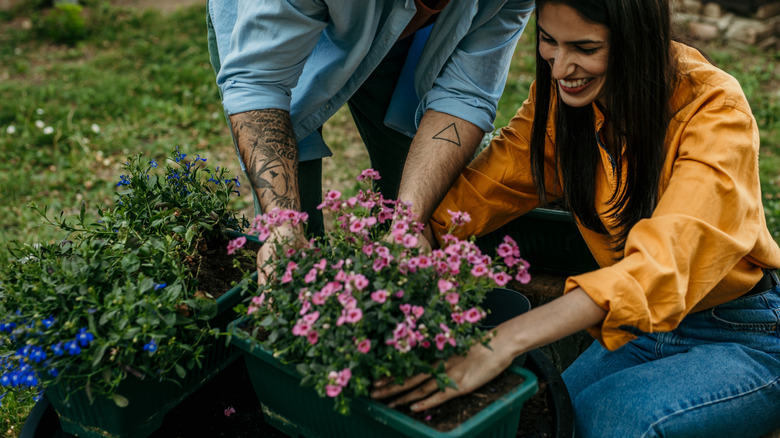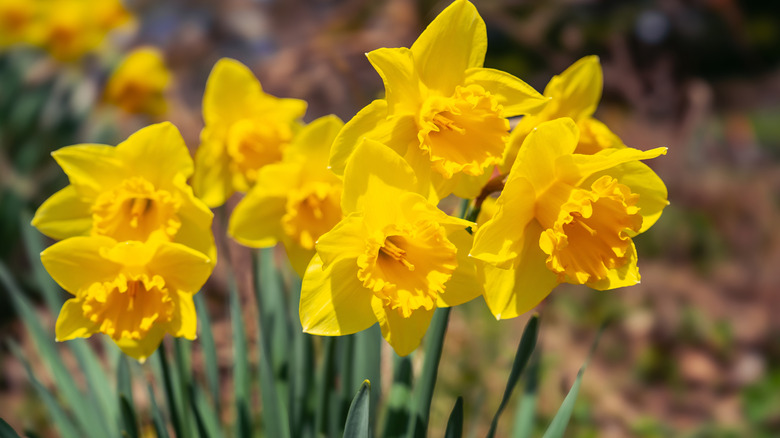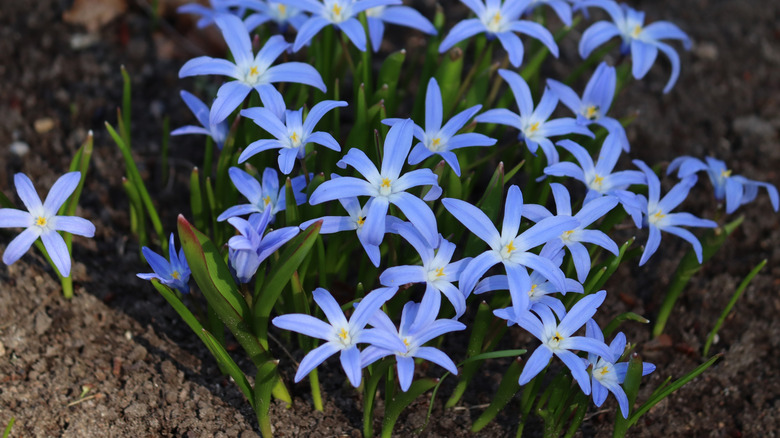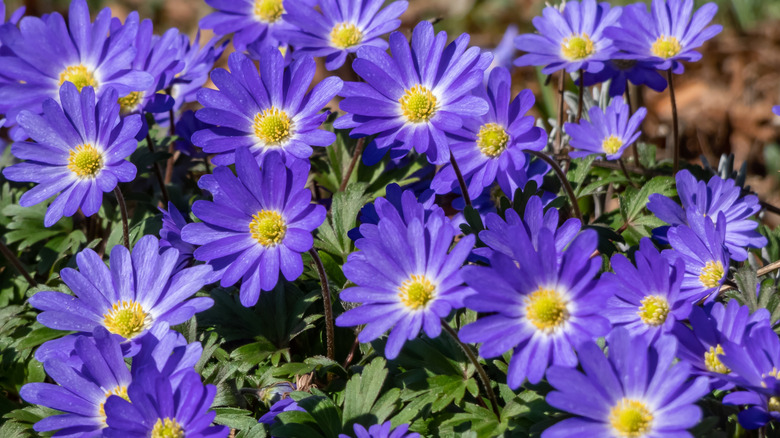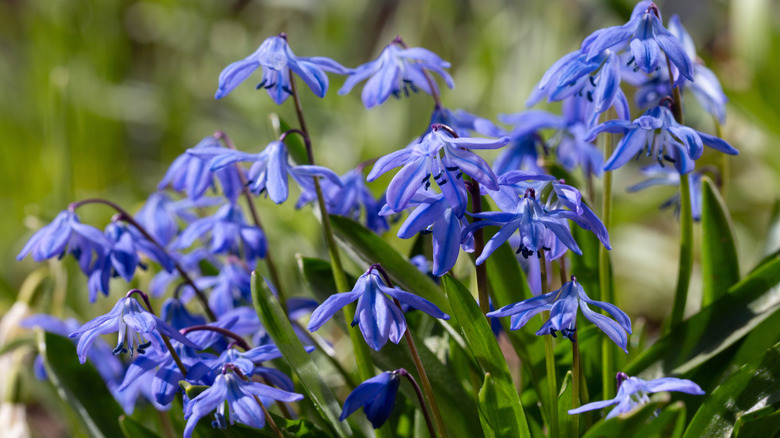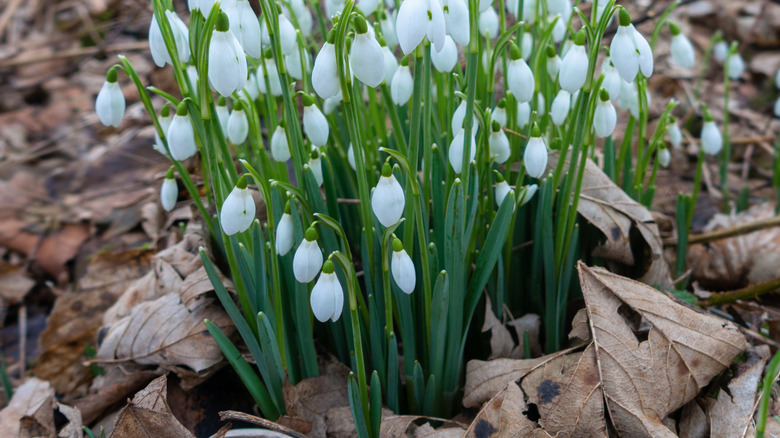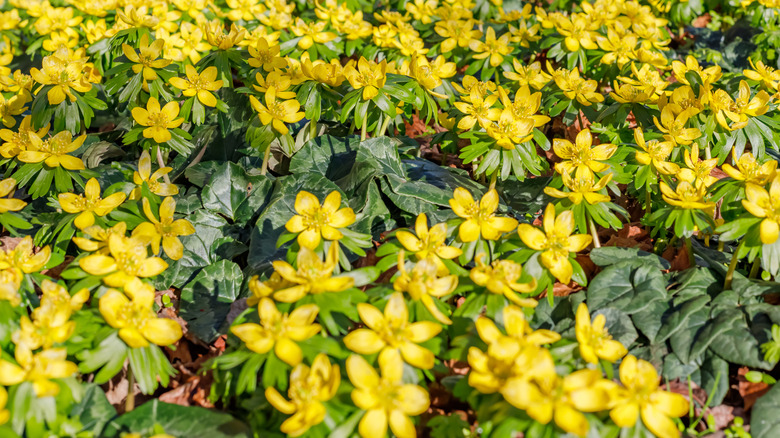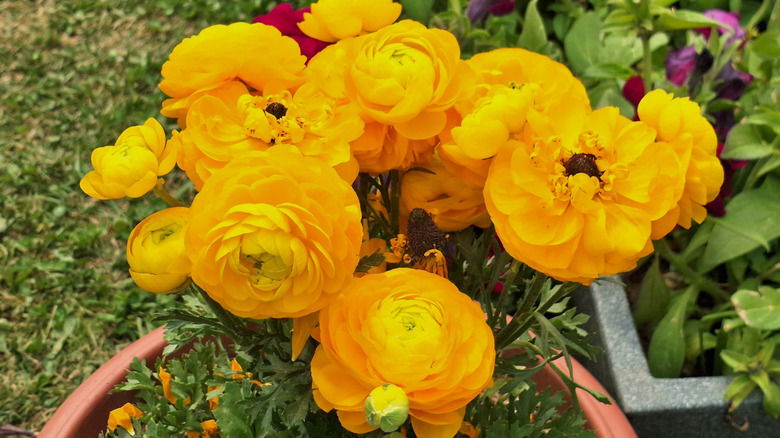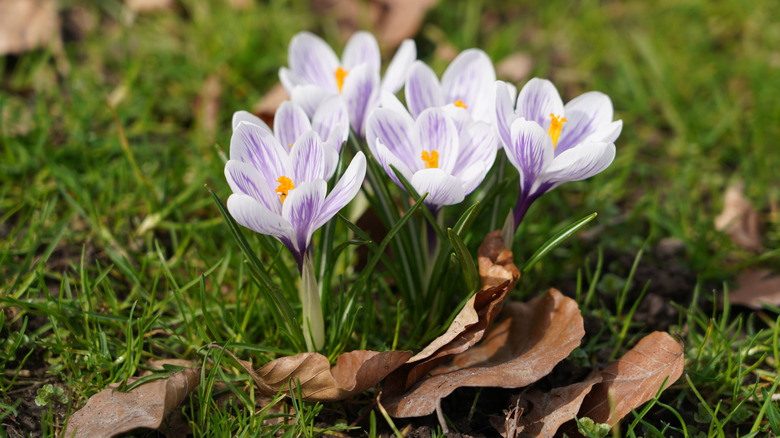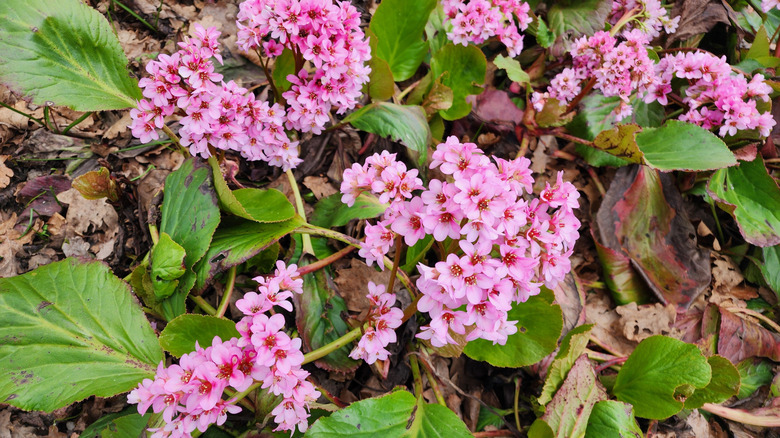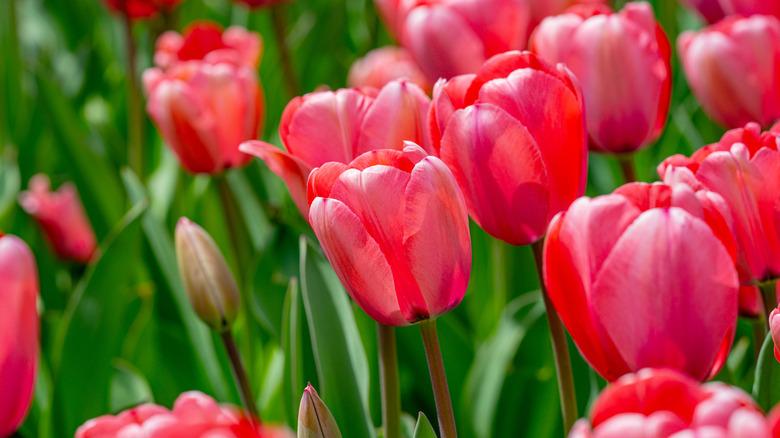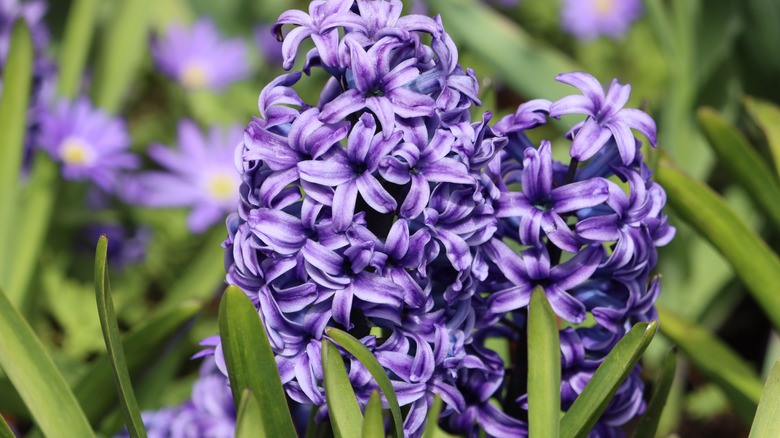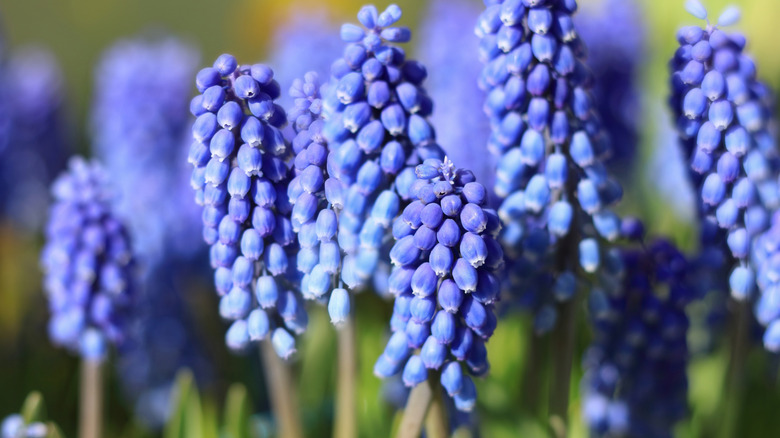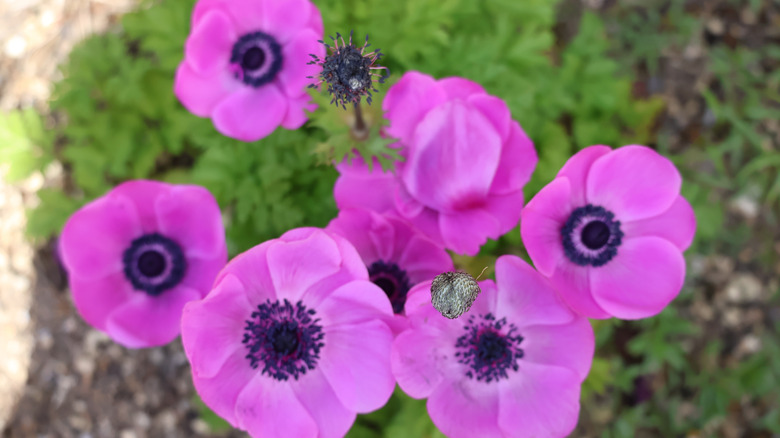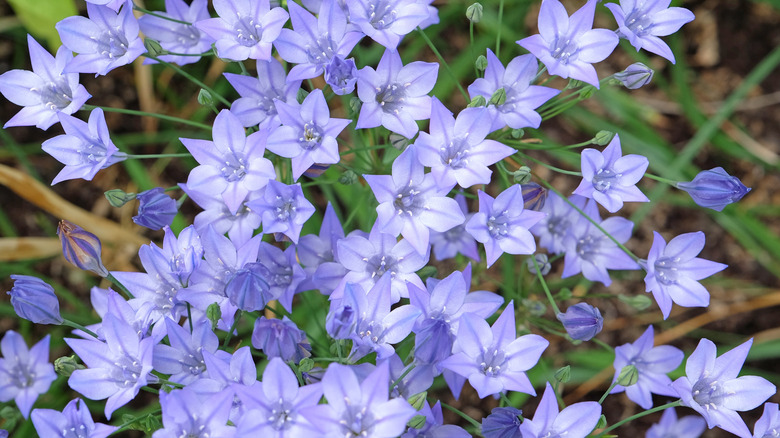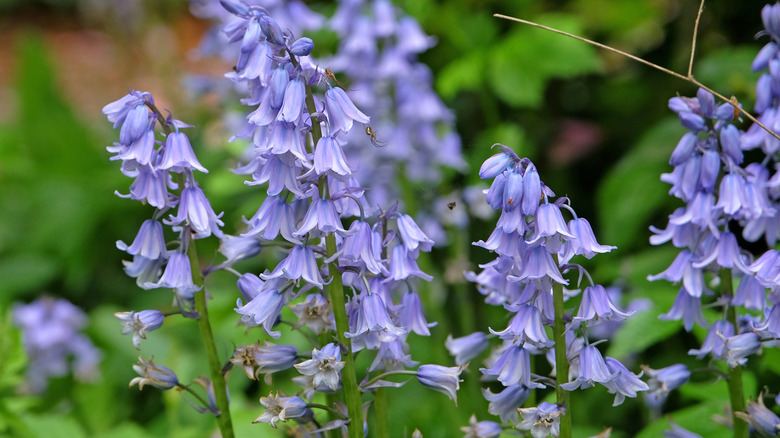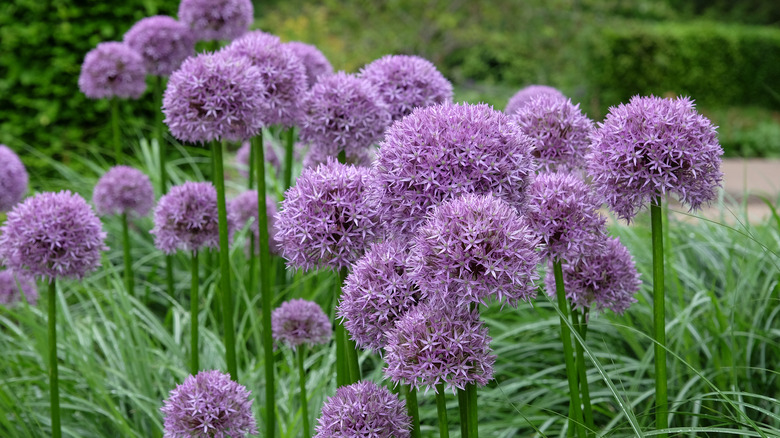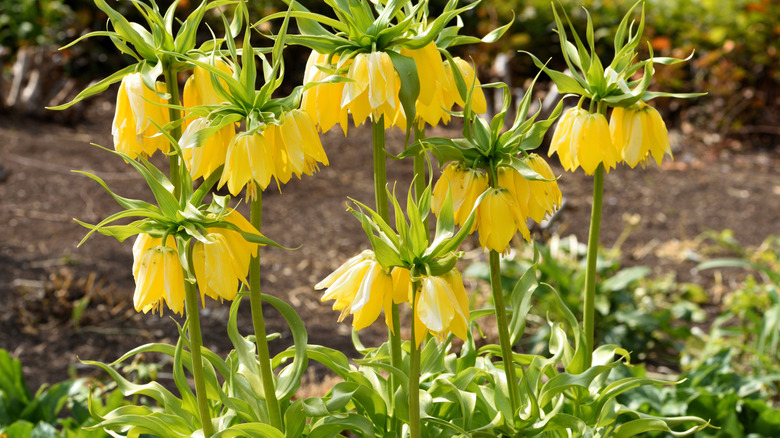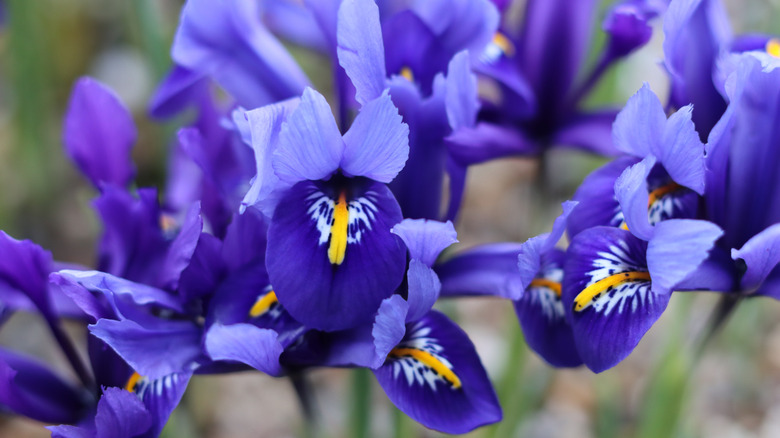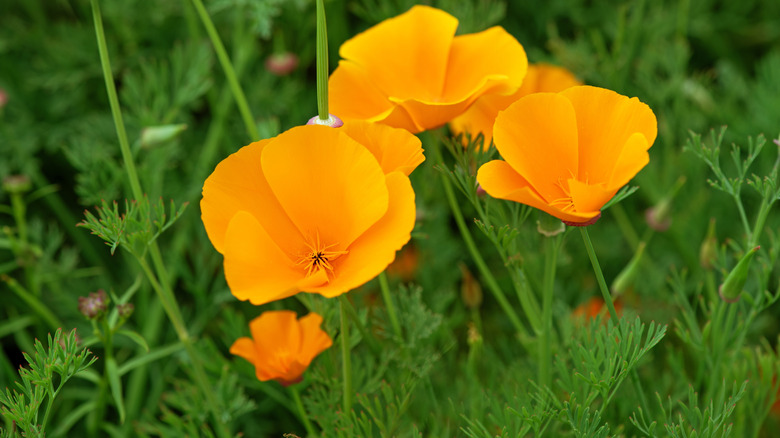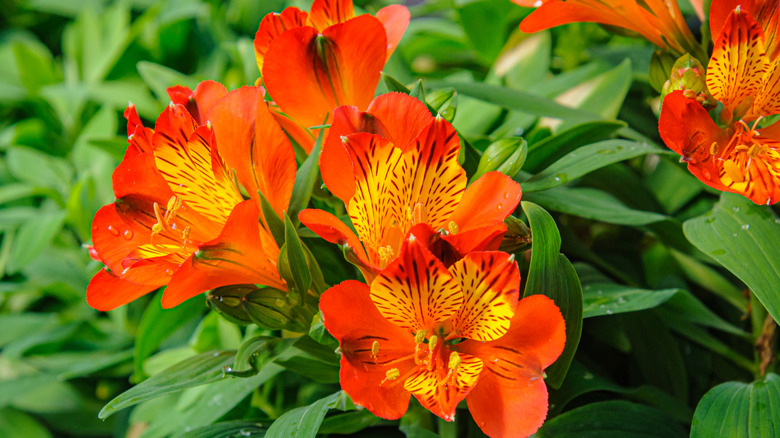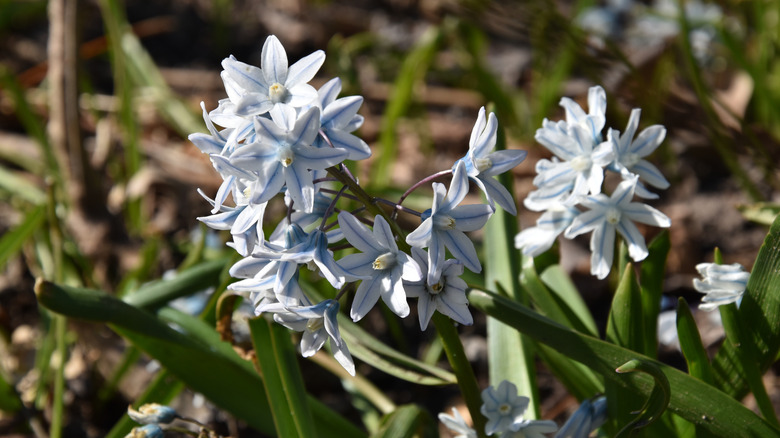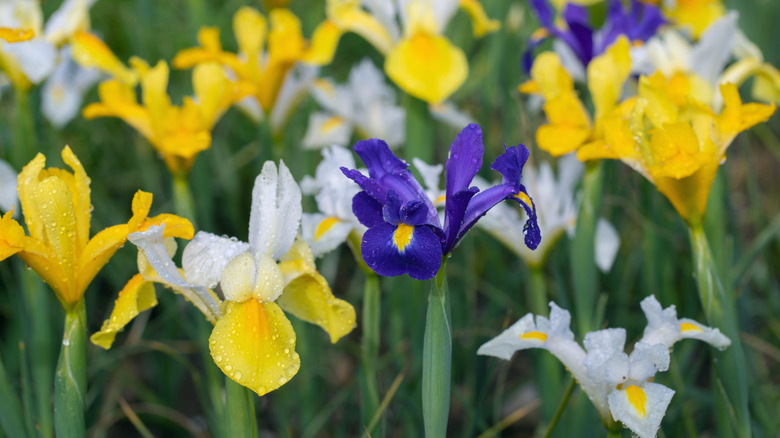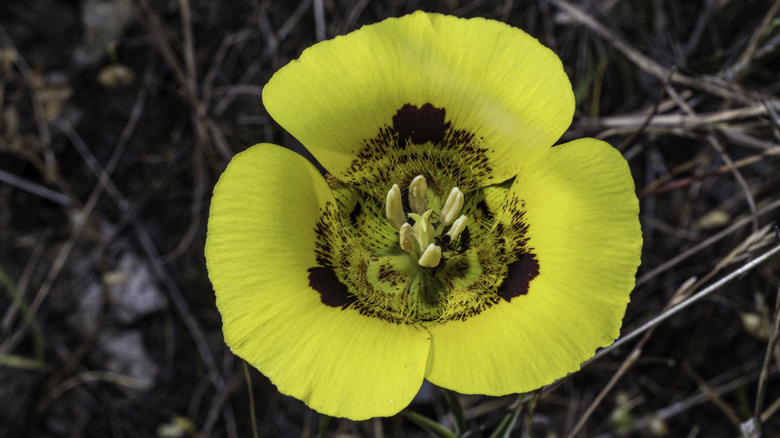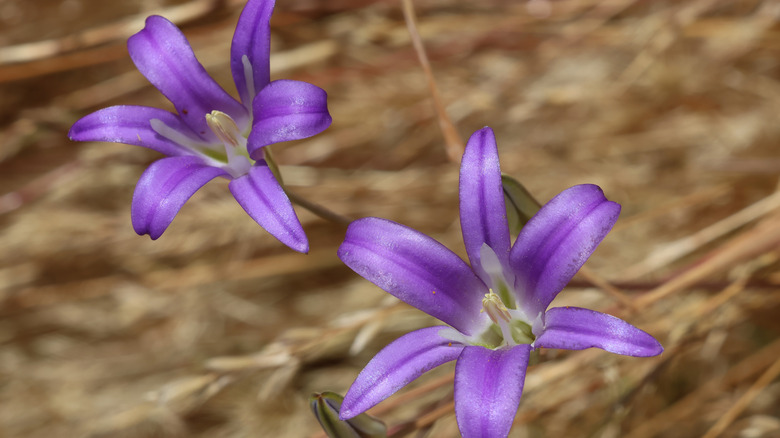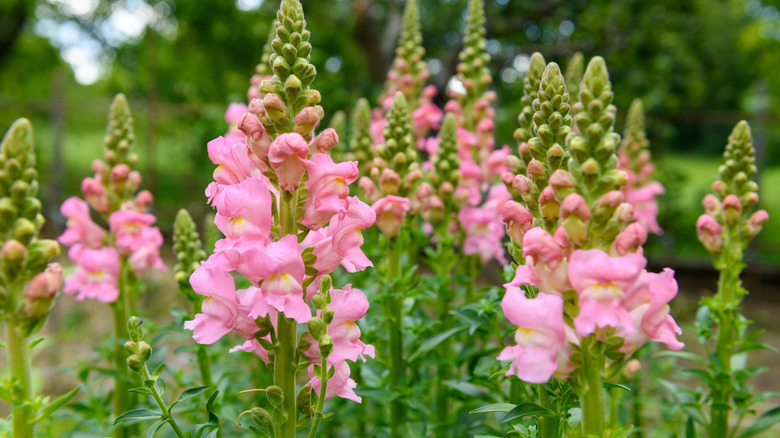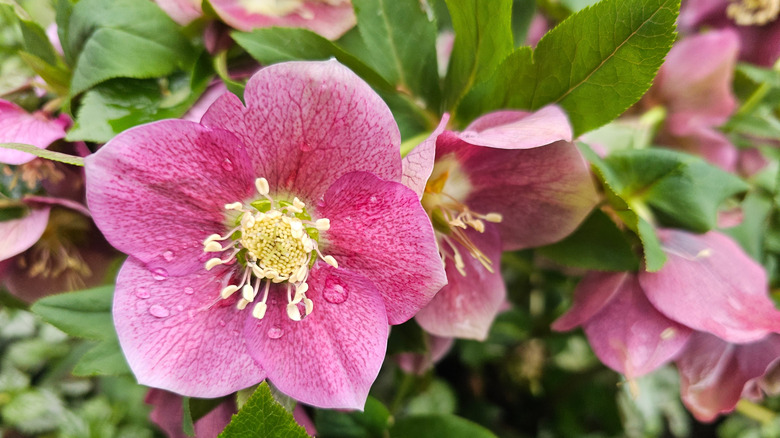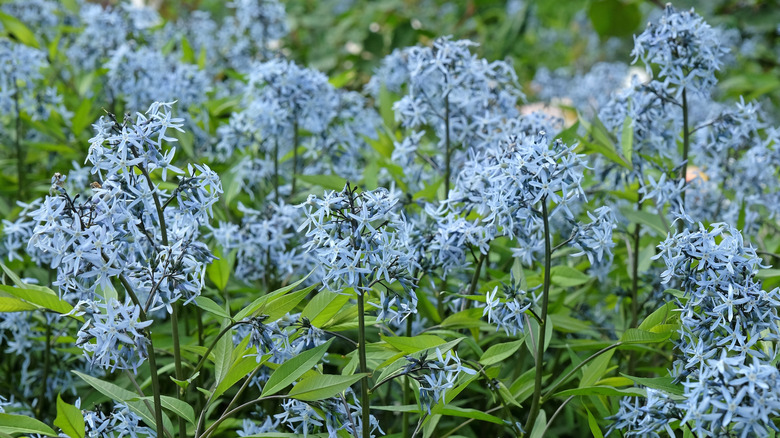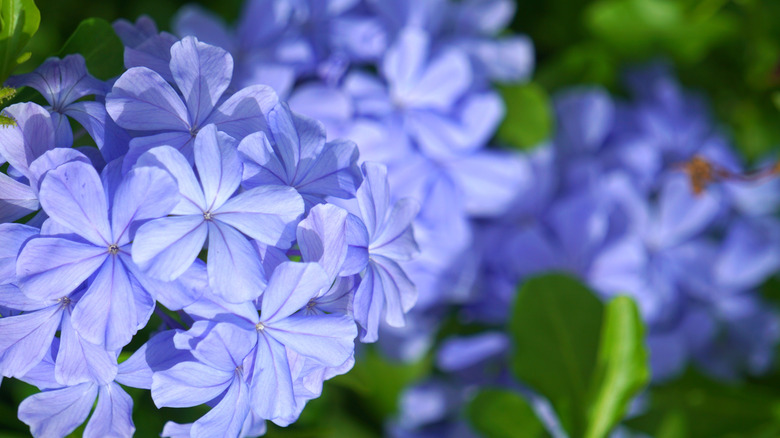28 Gorgeous Flowers You Can Plant In Fall To Kickstart A Stunning Spring Garden
To some, fall is the time of mums and pumpkins; to others, it signifies clean up and picking dead leaves and limbs after deciduous trees are done flaunting their autumn colors. However, there is another to-do gardening chore you can utilize fall for: planting spring-blooming bulbs and flowers.
Planted in fall, flowers like daffodils, crocuses, snowdrops, anemones, aconites, irises, hyacinths, and many more get ample time to develop their roots before the winter sets in. Due to that, they can offer up a parade of color, sometimes as early as winter, but mostly in spring, enlivening the yard with the happy flights of early risers and pollinators.
As a rule, give these plantings at least three weeks for growth before the ground freezes and becomes unworkable. Also, ensure they're adaptive to your range — you don't want to risk planting frost-tender plants in cold climates. With that said, here are 28 gorgeous flowers worth planting in the fall for a fabulous spring garden.
Daffodils
You can plant daffodil bulbs in October for beautiful blooms in the spring, or right through Thanksgiving if you live in a warm climate. Botanically called Narcissus, daffodils require excellent drainage to prevent bulb rot or else they won't flower. Give them at least half a day of sunlight. If desired, you can plant them underneath deciduous trees. However, remember to water and fertilize them more to ensure their resource needs are met. You can also plant various daffodil varieties in groups of three or twelve in beds or borders for a dramatic effect. They're perennials in zones 3 to 8.
Glory-of-the-snow
Christened so to mark its tendency to peek out of winter snow in zones 3 through 8, glory-of-the-snow (Chionodoxa forbesii) is another gorgeous flower worth planting in the fall. Through early spring, it's decked in blue, pink, or white petals that whirl out from white centers, depending on the variety. Place their bulbs in perennial beds or underneath trees (including black walnut, as they tolerate juglone) in full sun or partial shade. Glory-of-the-snow can self-seed, but if you'd like to control its spread, you can deadhead and collect seeds on your own and sow them before winter sets in.
Grecian windflower
To fill the tiniest crooks and crevices strewn in your landscape, give Grecian windflowers (Anemone blanda) a chance. These tiny plants grow no taller than 6 inches and herald spring with pleasing, purplish-blue flowers, though pink or white-blooming options are sold, too. Plant their corms through late fall in zones 7 through 9. To encourage early flowering, pre-soak and pre-sprout their bulbs before planting, especially in cold climates. Grecian windflowers enjoy full sun exposure and moist soils, but they tolerate light shade, as is available under tree canopies. Direct contact can cause contact dermatitis, and accidental ingestion can be poisonous.
Siberian squill
Carpet your spring gardens in a haze of blue with Siberian squill (Scilla siberica) by getting its bulbs into the soil during fall in zones 2 through 8. Bees out early in the season will thank you for the blooms, though deer and rabbits will dislike your planting choice. If naturalizing, you may appreciate Siberian squill for quickly filling the space through its offshoots and seeds. Otherwise, you may find it weedy for your beds. To keep the plant well-behaved, mow down spent blooms to prevent seed production. Siberian squill is invasive in a few eastern states and shouldn't be planted there.
Snowdrops
By planting snowdrops (Galanthus spp.), you can enjoy creamy-white flowers popping out of equally white snow, with this show set to last through early spring. For this view, however, you must plant their dry bulbs in the fall, preferably when the soil temperatures reach 40 degrees Fahrenheit. As snowdrops are compact in size, group them into fours for an outsized impact, or place them in front of evergreens where their blooms will have a beautiful backdrop. You can also pair them with spring-blooming perennials, such as Siberian squill and daffodils. Although it depends on the variety, snowdrops are hardy through zones 3 to 9.
Winter aconite
One of the earliest plants to welcome spring with its buttercup yellow flowers, winter aconite (Eranthis hyemalis) is a beautiful plant whose tubers can be planted during autumn. Generally, they're placed about 3 inches deep, but in heavy soils, you may want to put them at a shallower level of 2 inches. Since they produce many offsets, they're best used to naturalize the area beneath tall shrubs and trees. Otherwise, you may need to separate the extra bulbs frequently to contain their spread. Alternatively, you can sow their seeds during the fall in zones 4 through 7.
Ranunculus
Ranunculus provides pretty spring color with its multi-fold, rose-like, papery flowers, and its corms can be planted in the fall in zones 8 and warmer. But in extreme cold climates, it's best to push the planting to after a hard frost and treat them as annuals. To encourage early flowering, pre-soak their corms. Ranunculus species are available in many growth habits, from short ones that fit snugly into containers to tall options that can be snipped for cut arrangements. Offer them at least six hours of direct sunlight. Do note that these plants can cause contact dermatitis in sensitive individuals.
Crocus
Fall is the perfect time of year to plant a crocus because it gives the corms adequate time to develop their roots over the cold months. Planted right and exposed to full sun, crocus will offer early spring color in February or March, knitting a breathtaking sight in woodland lots, rock gardens, or around pathways. Space the corms about 2 inches apart in cool soil before it freezes. Beware: squirrels relish corms as late-season food, so you many need to protect them after planting. It overwinters successfully in zones 3 through 8.
Pigsqueak
In frost-free climates, you may plant pigsqueak (Bergenia spp.) in early fall to enjoy delicate pink blooms in spring. As Bergenia is a low-grower and boasts attractive foliage year-round — often turning bronze during fall — it functions as a flowering groundcover. As a bonus, it can choke out weedy growth. Pigsqueak garners little attention from deer, but lots from butterflies and other pollinators. It thrives in shaded spots swathed in moist, fertile soils, but can also adapt to heavy, clay soils. Spring-blooming snowdrops and crocuses serve as attractive companions.
Tulips
Tulips (Tulipa spp.) can be successfully planted in October right through December, if the ground is workable. Since tulips come in many shapes and sizes, simply measure their diameter and multiply it by three to arrive at the desired planting depth. You may want to give their bulbs a dose of bonemeal for brilliant blooms come spring. Tulips grow best in full sun or dappled shade. Since they lose vigor a year into planting, they're usually grown as annuals, though species tulips are perennial. Maximize their impact by planting them in groups of 10 (if tall) or 50 (if diminutive).
Garden hyacinth
To perfume your landscapes in spring, plant garden hyacinth (Hyacinthus orientalis) in the fall before the ground freezes over. However, bear in mind that garden hyacinths tend to lose their vigor with each passing year and are generally short-lived perennials in zones 4 through 8. Also, make sure to wash your hands after planting the bulbs or wear gloves, as they carry tiny barbs that can lodge in the skin. You'll need to cordon off their site from pets and little humans because the plant contains toxic alkaloids that can be irritating. Garden hyacinths thrive in sunny, organically rich, loamy soils.
Grape hyacinth
Available in a spectrum of colors, including blue, pink, and white, grape hyacinths (Muscari spp.) are perennial bulbs you can plant in the fall for early to mid-spring color. Dig into the beds about 3 inches deep to place the bulbs and space them similarly apart. Although they're most vigorous in sunny sites, dappled shade prolongs flower life. Plant grape hyacinths in groups of 25 for the maximum impact. Deadhead regularly and remove volunteer seedlings to prevent them from turning weedy. Outside of their hardiness range of zones 4 to 8, you can pop them in containers.
Poppy anemone
If you live in USDA zones 7 through 10, you can plant poppy anemone (Anemone coronaria) during autumn. Simply dig the soil about 3 inches deep and place the tuberous rhizomes. By April, they'll produce black-eyed, red or blue flowers. Poppy anemones perform best in moist, organically-enriched soils. They tolerate partial shade, but prefer full sun exposure. You may have to monitor their growth for cutworms and caterpillars, though they resist deer and rabbits. Like most bulbous plants, touching their tubers may irritate the skin, so take the necessary precautions.
Ithuriel's spear
Keeping to its name, Ithuriel's spear (Triteleia laxa) produces trumpet-like flowers that stand atop their stems in a spear-like resemblance. Native to California, this spring-through-summer bloomer is hardy in zones 6 to 9, but can be planted in zone 5 with winter mulch. Plant their bulbs in October through November in moist, workable soils (or after rains) to the depth of 5 inches and space them about 4 inches apart. They can be planted in most soils, including sand and clay, and tolerate full-to-partial sun. However, be sure to keep their beds dry in the summer or the corms will rot.
Spanish bluebells
To add a pop of blue or purple to late spring gardens, consider planting Spanish bluebells or wood hyacinth (Hyacinthoides hispanica) in the fall. Hardy through zones 3 to 8, their bulbs tolerate temperature drops to 15 degrees Fahrenheit. Spanish bluebells look their best in woodland settings, where they're partially shaded from sunlight. However, if forced, they can tolerate full sun. Plant them near hardscape or define their edges to prevent them from taking over the beds, or use them as a fast-growing groundcover. Spanish bluebells irritate skin and can be fatal if consumed, so choose their site accordingly.
Allium
When propagated through bulbs (rather than nursery starts), alliums or ornamental onions are placed in the garden soil during fall. That way, depending on the variety, you can expect globe-shaped blooms in late spring or summer. For spring color, utilize giant onion (A. giganteum) and its other varieties, Persian onion (A. aflatunense), or Star of Persia (A. christophii). For the most part, alliums are hardy in zones 4 through 9, but it may vary across species. Also, note they grow unkempt after flowering and are best planted behind ornamentals that can mask their dying foliage in summer.
Crown imperial
Crown imperial (Fritillaria imperialis) almost rewards its orange, yellow, or red flowers for good performance with a crown of green tuft, making for an eclectic appearance. Since these plants smell like garlic, they keep mammals at an arm's distance. From bulbs planted in the fall, the crown imperial sprouts nearly 4-foot-tall foliage that sadly dies back in the summer heat. But it'll overwinter and green up the next spring in zones 5 to 8, provided the soil remains consistently moist during dormancy and is mulched. Surprisingly, crown imperial performs well even in unamended clay or heavy soils.
Dwarf iris
Topping out at 4 inches, dwarf iris (Iris reticulata) is a low-growing ornamental you can tap into to brighten the dreary, wintry landscapes. Massed on the ground covered in purplish-blue flowers, they give off the impression of butterflies in play during late winter through early spring. Plant the bulbs with their pointed edges facing the sky about 3 inches deep and space them apart similarly. Although they're cold-hardy in zones 5 through 8 with winter mulch, dwarf irises are perennials but many people also grow them as annuals by replanting each year.
California poppy
California poppies (Eschscholzia californica) are a good alternative if you've never had luck growing tulips. In late spring, these reseeding annuals sprout tall stems decked in orange or golden blooms that continue to appear through the summer. All you've to do is sow the seeds in early fall. Once the seedheads are dry, the plants will self-seed in the garden, ensuring their return year after year. You may have to spray horticultural oil on these plants to prevent aphids from reducing their foliage to dust. California poppies can be used as a springy groundcover or in containers.
Freesia
In frost-free climates of zones 9 and 10, where freesias or baboon flowers successfully overwinter, you may plant the corms in your garden during autumn. Ensure the pointy top faces up and is 2 inches deep into the soil. In cooler climates, keep them in pots so you may move them inside before it freezes. Usually, the fragrant, showy flowers will bloom in about 12 weeks from planting, providing a vibrant pop of color from late winter to early spring. Freesias should be massed in groups of eight, with every bulb about 3 inches away, to create the best show.
Striped squill
In zones 4 through 8, you may plant the bulbs of striped squill (Puschkinia scilloides) in the fall garden. Just make sure they're at least 3 inches apart to not overcrowd the beds and laid at a depth of 3 inches. Toward the end of winter and right on through spring, this 6-inch-high ephemeral will bear blue-striped, perfumed white flowers. Because it's deer-resistant, you can mass it in borders for deterrence. They'll need full sun exposure, though they work with dappled and light shade. Striped squill self-sows in the landscape and can be divided every few years for more plants.
Dutch iris
Dutch iris (Iris x hollandica) can be planted in the fall for orchid-like blooms in late spring in zones 6 though 9. Their bulbs must be placed about 5 inches deep into the soil, and when massed, should be about 6 inches apart to avoid overcrowding. Full sun exposure paired with well-draining soils create optimal growth conditions. Dutch irises prefer drier soil in the summer, so plant them in beds that aren't watered often to protect the bulbs. Since their flowers are long-lasting in vases, cut a few to bring spring cheer to your indoors.
Calochortus
If you're up for a challenge, give calochortus a chance. Encompassing over 70 species native to the western U.S., such as mariposa lilies, fairy lanterns, and white globe lilies, they're sure to grab eyeballs (both yours and of pollinators) with their pretty blooms in spring. However, you might be up for some hit and miss with them because they're extremely sensitive to drainage. While they can be planted in the fall in drier climates, places with heavy humidity or winter rains risk rotting the bulbs. There, you must start with seeds. Depending on the species, calochortus is hardy in zones 5 and warmer.
Harvest brodiaea
Native to Oregon and California, harvest brodiaea (Brodiaea elegans) is a long-blooming wildflower that, with its bluish-purple blooms, provides visual interest from late spring through summer. Since the seed-to-flower cycle can take several years, they're best propagated via corms that can be planted in the fall. Harvest brodiaea is extremely easy to care for because it has minimal water needs and tolerates all soils from sand to clay. It also does well in partially-shaded sites. Given that, you can use these wildflowers to naturalize a site or move them into containers for a more intentional design.
Snapdragons
In zones 8 to 11, snapdragons (Antirrhinum majus) can be planted in late fall for early spring blooms. Don't worry; they can bear a few light frosts without taking any significant hit to their growth. Offer them a partially shaded site and humus-dense, moist soils. If starting with seeds, be sure not to bury them in the soil as they require light to stimulate germination. Snapdragons look excellent in cottage gardens where they can be paired with cool-season annuals like pansies. You can also grow them in containers and snip a few blooms for floral arrangements.
Hellebores
Comprising the likes of Lenten roses, Christmas roses, and other hellebore hybrids, Hellebores (Helleborus spp.) are the flowers to get an head start on spring gardening. Whether you're trying to establish a flowery carpet under conifers or populate shaded perennial beds, shade-loving hellebores are a lovely choice. They're hardy through zones 4 to 9, but may shed their evergreen character beyond zone 6. Since their foliage is toxic, deer and rabbits avoid it. Unfortunately, it's just as harmful to our furry friends and kids, so pick their location accordingly. Hellebores perform best in alkaline soils.
Blue star
Blue stars (Amsonia spp.) are a visual treat, not just in spring when their powder blue blooms are on an enchanting display, but also in fall when their foliage turns a gorgeous bronze. With Amsonia boasting over 10 different plants, native to different U.S. areas, and variations in their color, habit, and hardiness levels, home gardeners are certain to find a variety they love. Blue stars are popular with hummingbirds and butterflies, but deer abhor them. These stunners will also thrive in patio containers with full sun exposure. Avoid growing them in fertile soils, or they'll become droopy.
Woodland phlox
Also known as blue phlox and wild sweet William, woodland phlox (Phlox divaricata) is another gorgeous flower you can propagate in fall, either through root cuttings or rooted stems. With that, your late spring garden will be filled with waves of sweet-smelling, blue flowers, with bumblebees, sphinx moths, and tiger swallowtails for company. Pair woodland phlox with spring ephemerals or bulbs to mask their dying foliage, or with shade-lovers like hellebores and lungwort. Woodland phlox is at home in zones 3 to 8 with partial shade exposure, though up north, it appreciates more sun.
